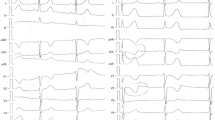Abstract
Introduction
Stimulant medications are approved to treat attention deficit hyperactivity disorder (ADHD) in children over the age of 6 years. Fatal ingestion of stimulants by children has been reported, although most ingestions do not result in severe toxicity. Lisdexamfetamine dimesylate, a once daily long-acting stimulant, is a prodrug requiring conversion to its active form, dextroamphetamine, in the bloodstream. Based on its unique pharmacokinetics, peak levels of d-amphetamine are delayed. We describe a case of accidental ingestion of lisdexamfetamine dimesylate in an infant.
Case Report
A previously healthy 10-month-old infant was admitted to the hospital with a 5-h history of tachycardia, hypertension, dyskinesia, and altered mental status of unknown etiology. Confirmatory urine testing, from a specimen collected approximately 16 h after the onset of symptoms, revealed an urine amphetamine concentration of 22,312 ng/mL (positive cutoff 200 ng/mL). The serum amphetamine concentration, from a specimen collected approximately 37 h after the onset of symptoms, was 68 ng/mL (positive cutoff 20 ng/mL). Urine and serum were both negative for methamphetamine, methylenedioxyamphetamine (MDA), methylenedioxymethamphetamine (MDMA, Ecstasy), and methylenedioxyethamphetamine (MDEA). During the hospitalization, it was discovered that the infant had access to lisdexamfetamine dimesylate prior to the onset of symptoms.
Conclusion
Amphetamine ingestions in young children are uncommon but do occur. Clinicians should be aware of signs and symptoms of amphetamine toxicity and consider ingestion when a pediatric patient presents with symptoms of a sympathetic toxidrome even when ingestion is denied.
Similar content being viewed by others
Abbreviations
- ADHD:
-
Attention deficit hyperactivity disorder
- GCS:
-
Glasgow Coma Scale
- LDX:
-
Lisdexamfetamine dimesylate
- LC/MS/MS:
-
Liquid chromatography-tandem mass spectrometry
- MDA:
-
Methylenedioxyamphetamine
- MDMA:
-
Methylenedioxymethamphetamine
- MDEA:
-
Methylenedioxyethamphetamine
- TSH:
-
Thyroid-stimulating hormone
References
Kaland ME, Klein-Schwartz W. Comparison of lisdexamfetamine and dextroamphetamine exposures reported to U.S. poison centers. Clin Toxicol. 2015;53:477–85.
Punja SSL, Hartling L, Urichuk L, Vandermeer B, Nikles CJ, Vohra S. Amphetamines for attention deficit hyperactivity disorder (ADHD) in children and adolescents. Cochrane Database Syst Rev. 2016;4:CD00996.
Fredriksen M, Halmoy A, Faraone SV, Haavik J. Long-term efficacy and safety of treatment with stimulants and atomoxetine in adult ADHD: a review of controlled and naturalistic studies. Eur Neuropsychopharmacol. 2013;23:508–27.
Rebec GV. Cocaine and amphetamines. eLS. 2012. doi:10.1038/npg.els.0004055.
Subcommittee on Attention-Deficit/Hyperactivity Disorder SCOQIAM. ADHD: clinical practice guideline for the diagnosis, evaluation, and treatment of attention-deficit/hyperactivity disorder in children and adolescents. Pediatrics. 2011;128:1007–22.
Goodman DW. Lisdexamfetamine dimesylate: the first prodrug stimulant. Psychiatry. 2007;4:39–45.
Akingbola OA, Singh D. Dexmedetomidine to treat lisdexamfetamine overdose and serotonin toxidrome in a 6-year-old girl. Am J Crit Care. 2012;21:456–9.
Ford JB, Albertson TE, Owen KP, Sutter ME, McKinney WB. Acute, sustained chorea in children after supratherapeutic dosing of amphetamine-derived medications. Pediatr Neurol. 2012;47:216–8.
Faraone SV, Buitelaar J. Comparing the efficacy of stimulants for ADHD in children and adolescents using meta-analysis. Eur Child Adolesc Psychiatry. 2010;19:353–64.
Spiller HA, Hays HL, Aleguas Jr A. Overdose of drugs for attention-deficit hyperactivity disorder: clinical presentation, mechanisms of toxicity, and management. CNS Drugs. 2013;27:531–43.
Micromedex® 1.0 (Healthcare Series), (electronic version) [Internet]. Greenwood Village (CO): Truven Health Analytics Inc; [date unknown][cited 2015]. Available from: http://www.micromedexsolutions.com/
Boellner SW, Stark JG, Krishnan S, Zhang Y. Pharmacokinetics of lisdexamfetamine dimesylate and its active metabolite, d-amphetamine, with increasing oral doses of lisdexamfetamine dimesylate in children with attention-deficit/hyperactivity disorder: a single-dose, randomized, open-label, crossover study. Clin Ther. 2010;32:252–64.
Acknowledgments
No funding was used for this case report.
Author information
Authors and Affiliations
Corresponding author
Ethics declarations
Conflict of Interest
The authors, Kelly E. Wood and Matthew D. Krasowski, have no conflicts of information to disclose.
Informed Consent
Informed consent for publication of this case was obtained and provided to the journal in accordance with the Journal of Medical Toxicology policy.
Additional information
This data has not been presented previously in any form.
Rights and permissions
About this article
Cite this article
Wood, K.E., Krasowski, M.D. An Infant with a Prolonged Sympathomimetic Toxidrome after Lisdexamfetamine Dimesylate Ingestion. J. Med. Toxicol. 12, 402–405 (2016). https://doi.org/10.1007/s13181-016-0560-x
Received:
Revised:
Accepted:
Published:
Issue Date:
DOI: https://doi.org/10.1007/s13181-016-0560-x




